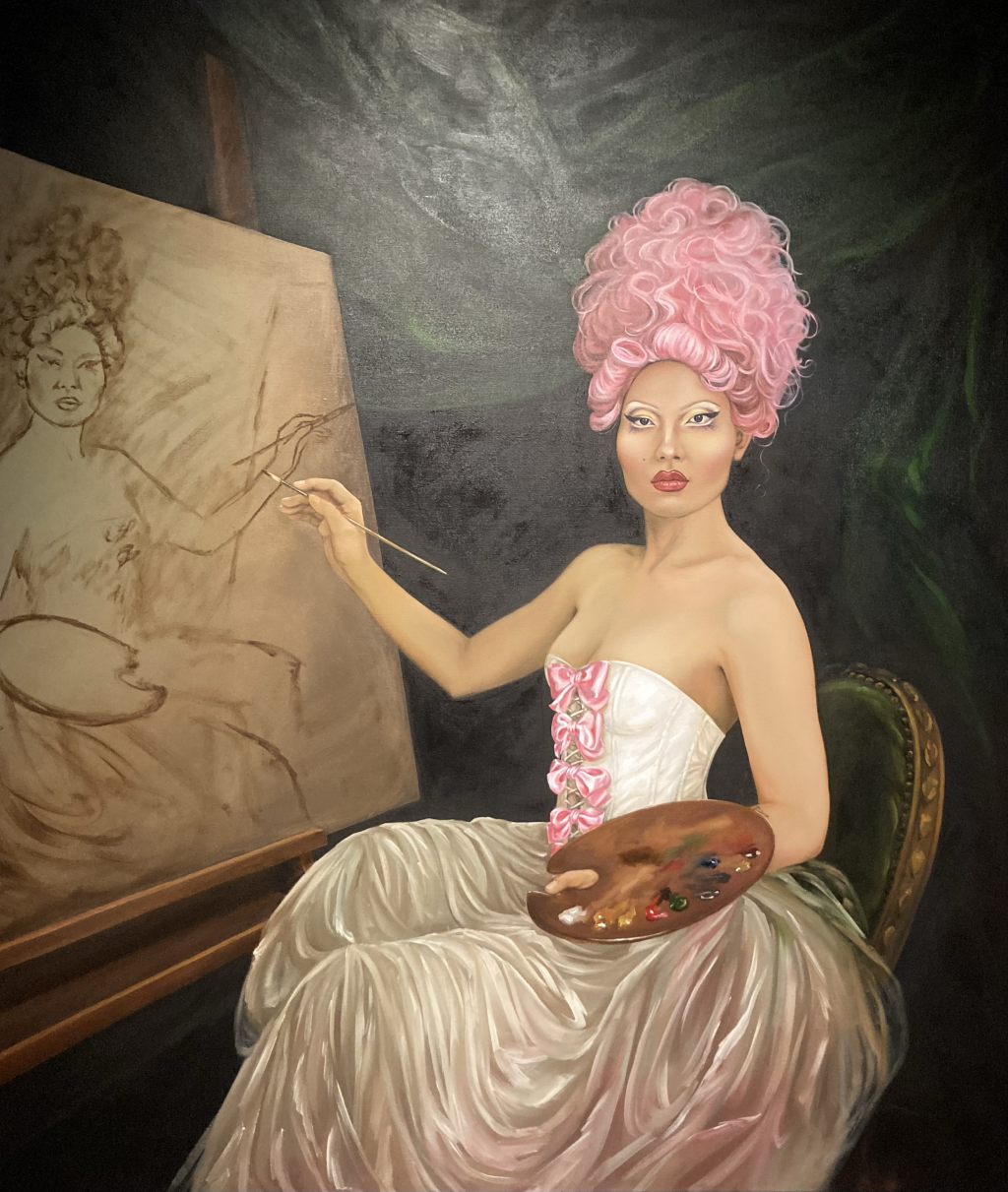The Cult of Beauty
Section outline
-

Xu Yang, Perhaps We are All Fictions in the Eye of the Beholder (2021). Oil on linen.
This painting is on display at the Wellcome Collection. As the wall text explains, "This is the first of an ongoing series of self-portraits by London-based Chinese artist Xu Yang. It references the practice of female portrait painters, especially Élisabeth Vigée Le Brun (1755-1842), whose work epitomised French beauty ideals of her day. Yang identifies with women in history restricted by social circumstances, while finding liberation in contemporary drag culture. Combining her inspirations with heightened experiences of racism during the pandemic, she asserts her agency to reconstruct self-identity and redefine beauty continuously through therapeutic self-portrait-making." If you'd like to learn more about the work, listen to artist Xu Yang discuss her painting here.
“Beauty is in the Eye of the Beholder”, we are often told. Or to put it in Shakespeare's words, “Beauty is bought by judgment of the eye” (Love's Labours Lost).
What comfort we are to take from such an expression is still unclear, especially in a world where to be beautiful often confers a form of power.
In 2024, conversations about beauty continue and have never felt more necessary, especially in an age of selfies and cosmetic surgery. Fortunately, our understanding about the relationship between beauty and power has become more sophisticated and nuanced.
This module begins, therefore, by putting a spotlight on Beauty as an entry point for a critical engagement with past and present debates on gender and politics.
This theme will be explored in our first lecture (What is Gender) and will be followed in Week 3 by a visit (during seminar time) to the Wellcome Collection’s temporary exhibition, The Cult of Beauty.
While the contributions you’ll encounter are predominantly taken from writings by feminist scholars, I trust the questions and issues will speak to you all, regardless of how you identify.
The following reading list brings together a range of perspectives and will be extremely useful when preparing for your visit to the exhibition and your first assignment.
- Sylvia Plath’s poem The Munich Mannequins, published in 1965. It famously starts off with the following line: Perfection is terrible, it cannot have children.
- Naomi Wolf (1991) The Beauty Myth. Vintage. Below you will find a PDF copy of the first chapter (The Beauty Myth), a required reading ahead of the visit. Print book available from QMUL Library.
- Simonetta Falasca-Zamponi (2012) The Politics of Aesthetics: Mussolini and fascist Italy. OpenDemocracy.
- Reina Lewis (2019) Modest Body Politics: The Commercial and Ideological Intersect of Fat, Black, and Muslim in the Modest Fashion Market and Media. Fashion Theory, Volume 23, Issue 2, pp. 243–273
- Lola Olufemi (2020) ‘Feminism and Food’, in Feminism, Interrupted. Disrupting Power. London, Pluto Press. Ebook available from QMUL Library.
- BBC (2022) How colourism led Tan France to bleach his skin.
- Afua Hirsh (2023) Decolonising My Body. A radical exploration of rituals and beauty. Square Peg. You can read an extract from the book here, and watch a short (7-minute) interview with the author
- Kajal Odedra (2023) Hair/Power. Essays on Control and Freedom. Inklings.
- Emma Dabiri (2023) Disobedient. Reclaim Your Unruly Beauty. London, Profile Books Ltd. You can listen Emma Dabiri discuss several works on display as part of the exhibition’s audio guide, while in this Mixed Up podcast Emma Dabiri reads an extract from her book and discusses beauty, power, and capitalist systems.
- Chiara Piazzesi (2023) The Paradox of Beauty. Femininity in the Age of Selfies. London, Rowman & Littlefield. You can also watch The Beauty Conviction: How to Break Women's Moral Obligation. If you do not speak Italian, you can switch on the English subtitles.
- Katherine Rowland (2023) A discussion with Naomi Klein on wellness culture: ‘We really are alive on the knife’s edge’, The Guardian, 15 November.
-
The audio guide contains the following tracks:
- Introduction to access resources
- Curator Janice Li introduces ‘The Cult of Beauty’ exhibition
- Historian Jennifer M. Rampling on the Ripley Scroll
- Professor Caroline Vout on the Esquiline Venus and Sleeping Hermaphroditus
- Writer Emma Dabiri discusses ‘The Game of Goose’
- Writer Emma Dabiri on ‘Racialised whiteness’
- Curator Janice Li on An Algorithmic Gaze II by Cecilie Waagner Falkenstrøm and the ARTificial Mind studio
- Writer Emma Dabiri on the ‘Hairstyles’ series by photographer J.D. ‘Okhai Ojeikere
- Artist Xu Yang on her painting ‘Perhaps We are all Fictions in the Eye of the Beholder’
- Artist Kimberley Burrows and cosmetic scientist Gabriela Daniels discuss accessibility and beauty
- Curator Janice Li introduces the Beauty Sensorium
- Artist Eszter Magyar (Makeupbrutalism) on her commission 'It makes no sense to be beautiful if no one is ugly'
- Artist Shirin Fathi on her work The Disobedient Nose
- Curator E-J Scott on the Museum of Transology
- Curator Janice Li introduces the film ‘Permissible Beauty’
- Curator Janice Li introduces the sculpture ‘(Almost) all of my dead mother’s beautiful things’ by the artist Narcissister
- Curator Janice Li introduces the installation ‘Mirror, mirror on the wall, Beauty unravelled in the virtual scroll’ by Xcessive Aesthetics
- Introduction to access resources
- Sylvia Plath’s poem The Munich Mannequins, published in 1965. It famously starts off with the following line: Perfection is terrible, it cannot have children.